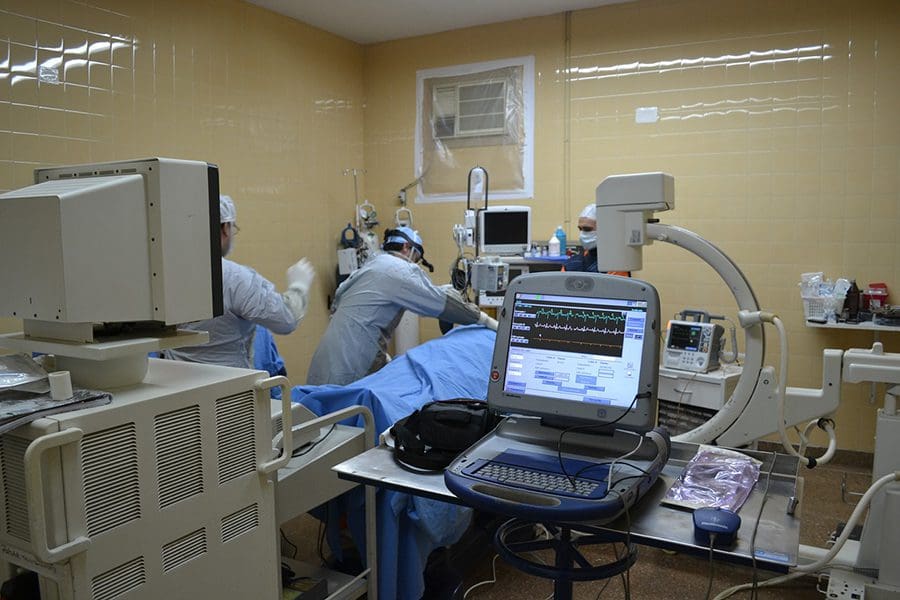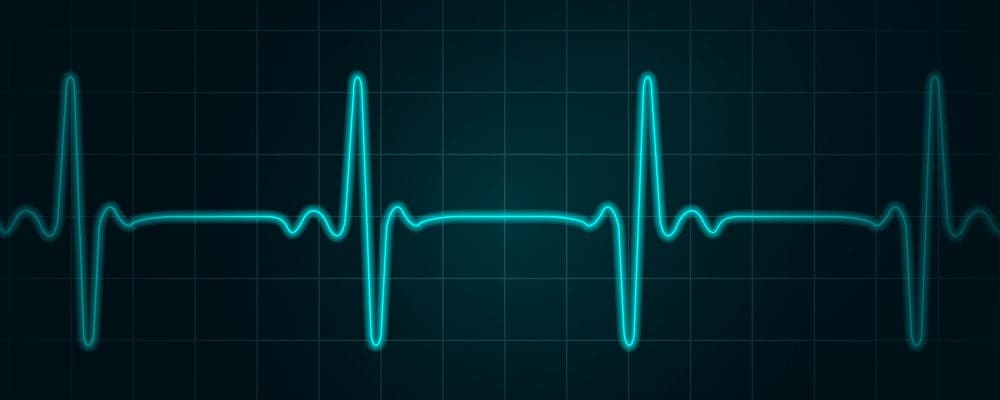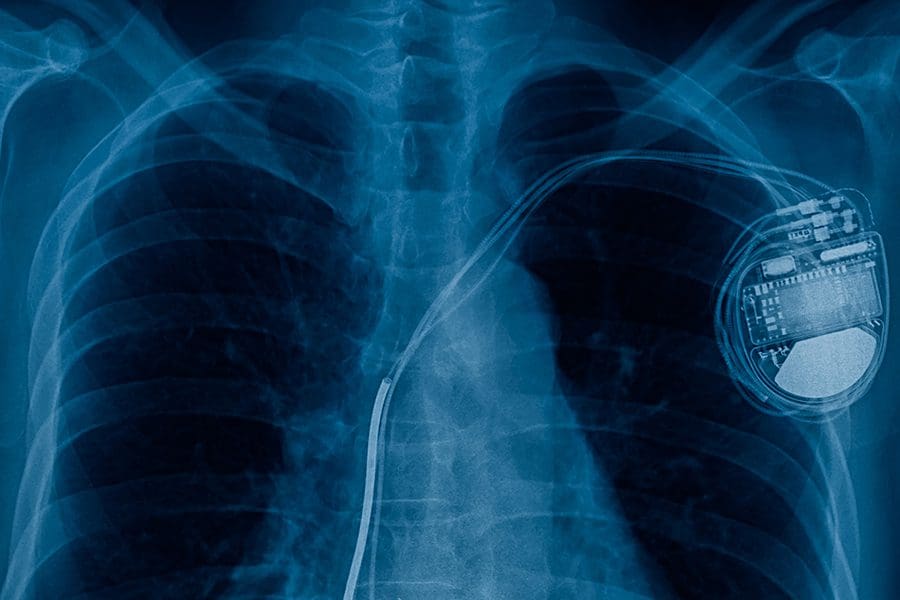EMF radiation"Radiation" in the context of Electromagnetic Fields (EMF) refers to the process by which energy is emitted and transmitted through space or a material medium in the form of electromagnetic... from common household appliances and electronic gadgets can interfere with implantable pacemakers and ICDs (implantable cardioverter defibrillators), say experts.
In 1952, American engineer Wilson Greatbatch invented a device that prevents more than 40% of global heart-related deaths. He called this device “the implantable cardiac pacemaker.” Right now, around three million people worldwide live healthy lives because of it.
Now imagine what would happen if something was to cause this device to malfunction. No, I’m not referring to an outside force or weak batteries. The thing I’m talking about is all around us, and there’s virtually no way for anyone to avoid it altogether.
I’m referring to the EMF that every one of us is exposed to on a daily basis.
EMF is a type of electrical energy"Energy" is a fundamental concept in physics, often described as the ability to do work or cause change. In everyday terms, it's what is needed to move things, heat them... that can transmit wirelessly. Since pacemakers use electrical signals to operate, EMF can massively interfere with their functioning. Prolonged EMF exposure has the ability to change the signals that regulate your heartbeat and even completely stop them.
In this post, we’re going to have an in-depth discussion about how EMF interferes with your pacemaker and how to keep it functioning safely, along with a few other important topics. So, let’s begin.

Want to Slash Your EMF Health Risks?
Want to Slash Your EMF Health Risks?
Good! Learn the one small change you should make right now.
Heart Rhythm Disorders
Before diving in deep and exploring how and why EMFs interfere with pacemakers, let’s understand why an individual needs a pacemaker in the first place.
The human heart is one of our most crucial organs. Its job is to pump blood throughout the body using our circulatory system, supplying tissues with oxygen and nutrients and removing waste materials.
This pumping of blood needs to be constant for us to survive.
Statistically, an average human’s heart beats at a rate of 60 to 100 beats per minute (bpm). This can, however, rise depending on the situation your body is in. For example, when you’re exercising, it’s normal for your heart to go above 100 bpm. But, in most cases, your heart rate doesn’t go below 60 bpm.
So, the concept is simple. If your heart rate is below 60 or above 100 when you’re in a relaxed state, this is an indication that your heart is not pumping blood properly and you’re suffering from some form of heart rhythm disorder. In this case, you’ll need to see a medical professional immediately because you may be at risk of problems like heart stroke, heart failure, and fainting (syncope) spells.
Minor heart rhythm disorders can be fixed with certain medications. But if this becomes a trend, you can undergo surgery. The doctors will implant a pacemaker under the skin near the heart to help mechanically regulate your heartbeat.
How Do Pacemakers Work?
The human body has a natural pacemaker called the sinus node. It’s an area of specialized cells in the upper right chamber of the heart. The sinus node sends electrical signals to your heart to make it pump blood.
The role of a pacemaker is to artificially take over your sinus node’s job when it’s not working as it’s supposed to.
Most pacemakers that are available on the market today consists of two parts:
- A small, metal, battery-operated computer that is typically implanted into the soft tissue beneath the skin in the chest
- Wires (leads/electrodes) that are implanted in your heart and connected to the computer
It takes surgeons an average of one to two hours to fit a pacemaker inside your body. But if you’re having other surgeries at the same time, it could take longer. Usually, you can leave the hospital the same day or the day after that without any hassles.
Why Do EMFs Interfere with Pacemakers?
“Things to avoid with a pacemaker” is one of the most frequently searched queries on Google. Pacemakers are intelligent devices, no doubt. But they’re also highly vulnerable to magnets and EMFs that are available all around us.
Exposure to magnets and EMFs can cause your device to function inadequately and sometimes even prevent the device from working altogether. So, why is that?
Before answering this, let’s first understand what magnets and EMFs are.
Magnets
Magnets are rock-like objects that create a force that can pull or push objects with a similar build. You can find them all around you. They’re in your electronic gadgets, electrical appliances, and even in debit and credit cards.
Magnets have this invisible fieldIn the context of electromagnetic fields (EMF), the term "field" refers to a region in space where electric and magnetic forces are exerted. An electromagnetic field is generated by electrically... that lets them attract or repel other items. You may have experienced this when bringing two magnets close to each other. The force between those two magnets is called a magnetic field.
When the magnetic field interacts with your pacemaker’s electrical pulses, it causes your implanted device to go into magnet mode. This means that it will suspend normal operations until the magnet is moved away from it.
Because of this very reason, the FDA recommends “patients keep any consumer electronic devices that may create magnetic interference, including cell phones and smartwatches, at least six inches away from implanted medical devices.”
Electromagnetic Fields
Electromagnetic fields (EMF) are a combination of electric and magnetic fieldsDefinition and Nature of Magnetic Fields Magnetic fields are a fundamental aspect of electromagnetic fields, produced by moving electric charges (electric currents). The strength of a magnetic field is measured....
When these two energies combine, it creates a new kind of energy – i.e., EMF, which can move and transfer data from point A to B without wires or cables. EMF is what our cell phones, laptops, tablets, and smart meters use to communicate with the network source.
Research studies show that when you keep EMF-emitting gadgets near your pacemaker, the external signals can cause your device to malfunction. Have a look.
The Research on Pacemakers & EMF
“Electromagnetic interference with pacemakers can result in bradycardia, or a slow heart rate,” says Andreas Napp, M.D. “The risk of interference depends on many different factors, such as the settings of the implant or strength of the field source.”
Napp, along with his colleagues, performed an experiment containing 119 patients with pacemakers. They exposed these patients to EMFs operating on 50Hz or 60Hz frequency"Frequency" in the context of electricity, Electromagnetic Fields (EMF), and wireless communication, can be thought of as the number of times something happens in a second. Specifically, it refers to... and slowly increased the frequency until they noted a pacemaker sensing failure.
Note that this experiment was conducted in a laboratory setting with expert supervision, so no patients were harmed.
This experiment proved that pacemakers are highly susceptible to EMFs operating in levels that we’re exposed to in our daily lives.
They also mentioned that holding the EMF source at a forearm’s length, which is slightly greater than 12 inches, significantly limits the risk of EMF interference with the pacemaker. “But further measures might be needed in environments with strong EMF, such as engines used in the processing or manufacturing industry,” Napp said.
Another study comes to us from Finland. In this study, the researchers exposed eleven volunteers wearing a pacemaker and 13 wearing an ICD to magnetic fields operating on the frequency between 2–200 Hz.
Out of the eleven pacemakers, three in unipolar settings were heavily affected by the exposure.
This study aimed to see if employees who had a recent pacemaker or ICD implant surgery could return to their place of employment, where they would be exposed to a high volume of EMF.
The researchers concluded that “in most cases, employees can return to work after implantation of a bipolar pacemaker or an ICD, after an appropriate risk assessment. Pacemakers programmed to unipolar configurations can cause danger to their users in environments with high electromagnetic fields, and should be avoided, if possible.”
Tech Companies Warn Patients with Pacemakers
If you read carefully, you can find a pacemaker warning in most products’ user manuals.
For example, Sleep Connection says that their wrist bands are unsuitable for people with a pacemaker or other medical implants with electronic components. Vetek clearly states in the manual that their weighing scales are not suitable for people with a pacemaker or other cardiac stimulator.
These are just a couple of examples. From small companies to big tech brands, the majority of them put a pacemaker warning either in their user manuals or their websites.
Other companies include Merrychef, Bosch, and Panasonic. Their microwave ovens are known as some of the best in the market. And if you look at their user manuals, all of them state that their device may not be safe for users wearing a pacemaker. And they urge such users to consult with their physician before using the appliance.
So, you see, the risks to your pacemaker from everyday gadgets are real. Even the manufacturers say so.
And, if you wear an implanted medical device, you must ensure caution while interacting with EMF-emitting gadgets or appliances.
Be Cautious Around These Devices
Many studies like this show how exposing your pacemaker to EMF for a long time can prove detrimental to your health.
Although modern pacemakers and ICDs are designed with EMF safety in mind, they’re not completely resilient to the EMF pollution around us. So, if you wear an implanted medical device, here’s a list of some EMF sources that I recommend you be cautious around or stay as far away from as you can.
EAS or Anti-theft systems
Electronic Article Surveillance or EAS systems are common in shopping sites like malls and departmental stores. Researchers say that being near EAS systems for a long time can cause problems with your pacemaker.
Sometimes, these EAS systems are hidden or camouflaged near the exits of businesses. So, be aware of that, and make sure that you’re not lingering around these systems for any longer than necessary.
Metal Detectors for Security
Similar to EAS systems, metal detectors like those you find in airports can also pose a significant risk to your pacemaker. So, make sure to let the authorities know that you’re wearing this device, and that the radiation from the scanners can disrupt its functioning.
You can also request an alternative form of inspection, like pat-down instead of hand-held scanners.
You can refer to the Transportation Security Administration (TSA) advisory page for more information.
Cell phones
Cell phones, as you already know, emit RF (radiofrequency) signals to communicate with the network source. And per research studies, these RF signals emitted by cell phones have the ability to make your pacemaker or ICD less reliable.
So, make sure that you’re not keeping your cell phone close to your body or your pacemaker. This means not carrying your cell phone in your pocket or bra.
If you have no option but to carry your phone on your body, switch it off, or turn the airplane mode on. Read my post on “Airplane Mode” to learn more about how this feature helps you and how you can turn it on.
Laptops
Laptops, just like cell phones, also emit RF signals. Despite their name, laptops are not made for laps. And if you read the instruction manuals from laptop manufacturers carefully, you’ll see that almost all of them recommend a healthy distance between the laptop and your body.
So, make sure to keep your laptop on the table and sit on a chair to create distance between your body and the device. Also, if possible, change to a wired internet connection to reduce your EMF exposure. Read my post on why wired internet is better and how can you switch to it for more information.
Besides laptops and cell phones, tablets, MP3 players, headphones, and e-Readers also fall in the same risk spectrum. So, take necessary precautions before using these devices.
Microwave Ovens
Microwave ovens are nowhere near as harmless as they look. This device emits microwave radiationMicrowave radiation is a form of electromagnetic radiation with wavelengths ranging from one meter to one millimeter; with frequencies between 300 MHz (0.3 GHz) and 300 GHz. This type of... which lies right next to radiofrequency in the electromagnetic spectrumThe electromagnetic spectrum encompasses the entire range of electromagnetic radiation, which varies in wavelength and frequency. This spectrum includes, in order of increasing frequency and decreasing wavelength, radio waves, microwaves,....
When you stand near a running microwave oven for a long time, the microwave energy can cause unwanted currents to flow in the electric leads of your implanted medical device.
This may cause your implant to malfunction, which results in a range of problems. So, make sure you’re not staying near a running microwave oven for a prolonged period. If you need to use it, simply turn it on, and move as far away as you can from the oven until your food is heated. And once you’re done, turn it off.
RF- Based Medical, Diagnostic and Cosmetic Procedures
There are many medical treatments that either use magnets or electromagnetic radiationElectromagnetic radiation refers to the waves of the electromagnetic field, propagating through space, carrying electromagnetic radiant energy. It includes a wide range of electromagnetic waves, from very long radio waves.... Here’s a list of some of them:
- Extracorporeal shock-wave lithotripsy (ESWL)
- Magnetic resonance imaging (MRI)
- Radiofrequency ablation (RFA) or microwave ablation
- High-frequency, short-wave, or microwave diathermy
- Therapeutic radiation
- Transcutaneous electrical nerve stimulation (TENS)
- CT and CAT Scans
- Electrolysis
- Electrocauterization
All of these treatments and procedures can pose a significant risk to your pacemaker or ICD. So, avoid these as much as you can. This means opening up to your doctor about it and asking for an alternative.
Important Things to Remember After an Implant Surgery
Wearing a pacemaker doesn’t mean that you’ll have to live a highly restricted life. It’s just that you’ve got to be slightly more cautious about things because your pacemaker is now a part of you—and a very significant one.
Here are some things that you need to follow once your surgery is complete.

Take Medications
Having a pacemaker implant surgery does not exclude you from taking your heart medications. This is because the medicines that your doctor prescribes have specific effects on your heart and overall health.
Besides that, doctors also sometimes program pacemakers to be in line with the medications. So, if you stop taking them without consulting your doctor first, it can create problems.
Avoid Pressure on Your Pacemaker Site.
Garments and other gear that you wear can sometimes rub against your incision site, which can cause problems. So, make sure to always place soft padding on the area where your pacemaker is.
Experts also recommend avoiding rough contact sports, which can put pressure on your pacemaker.
Notify That You’re Wearing a Pacemaker
As I already mentioned in the above sections, there are many things that can cause your pacemaker to act up. Whether it’s medical a procedure like an MRI or CAT scan, or a metal detector in an airport, you need to notify the concerned people of your situation.
I recommend carrying your pacemaker ID card at all times. This way, you can prove your implant without any hassles. Also, if you require emergency treatment, it’ll be easier for emergency caregivers to identify the type of pacemaker you have.
Mitigate Your EMF Exposure
Besides staying in line with the post-surgery protocols, mitigating your EMF exposure is the most important thing that you need to do.
We have a simple rule of thumb that you can apply in your life to ensure you’re not exposed to a heavy amount of EMF. It’s called “Minimize Use & Maximize Distance.”
As you can see, it’s divided into two parts.
For the first part, simply minimize your tech use. This means reducing your use of electronic gadgets to the bare minimum, and cutting out unnecessary exposure, like not leaving your WiFi on all night.
For the second part, you need to maximize your distance from EMF-emitting gadgets. Because, you see, the further you move from an EMF source, the less EMF you’ll be exposed to.
So, make sure to do things like not carrying your phone in your pocket or bra and keeping your WiFi router at least 5 meters away from where you spend the most time.
I have a separate post that contains more tips on how to reduce your EMF exposure for free. It’s called “The Best EMF Protection.” So do give it a read.
Final Thoughts
Wearing a pacemaker doesn’t mean that you can’t live a normal life. You just have to be a bit more careful about your surroundings and what you’re interacting with.
I get that it’s hard to be aware of every possible interference that may be coming towards you. But your pacemaker’s safety is in your hands. As I already mentioned, notifying people that you have a pacemaker, which translates to some limitations, will ease a lot of pressure for you.
It’s also worth focusing on EMF mitigation as much as you can. And it’s not that hard to do. I have an entire page dedicated to tips for EMF mitigation and living a healthy life. The page is called “SYB Healthy Living Tips.” So, give it a visit.










